I wrote this book to provide a road map for corporate managers and small-business owners to understand how the business cycle affects not only the general economy but also their companies no matter in what sector their businesses operate, and how to prepare for the inevitable downturns in the economy. As we shall see, recessions are unfortunately inevitable in our mixed economy, where the Federal Reserve has taken on the responsibility to “manage” the economy to provide high employment and low inflation by targeting short-term interest rates. We will examine the Federal Reserve’s track record, and readers can reach their own conclusions about the Fed’s policies.
When the economy is booming—or at least expanding at a moderate rate—and prosperity seems limitless, a recession seemingly comes out of “nowhere.” Many (most?) business decision makers are caught completely off guard as economy rolls over. Why have experienced corporate managers and entrepreneurs failed to recognize the signs that a recession is unfolding? Navigating the Boom-Bust Cycle: An Entrepreneur’s Survival Guide therefore fulfills a much-needed void, a guide for business decision makers to get “ahead of the curve” as the business cycle unfolds. In short, my book gives business decision makers a leg up on their competition.
The business cycle in the United States has been characterized by an ongoing series of economic booms and busts, bubbles and bursts—despite efforts by the Federal Reserve to stabilize the ups and downs since it was created in 1913. Since then, the U.S. economy had the “forgotten depression” of the early 1920s, followed by the Roaring Twenties, and then the more than decade-long Great Depression. After the seemingly endless post–World War II prosperity that lasted for nearly three decades, many companies were unprepared for the 1970s stagflation. The boom of the 1980s continued into the 1990s, and, as we shall see, paved the way for dot-com bubble, the housing bubble, and now what some analysts have called the “everything bubble.”
When will the everything bubble burst? How can corporate executives and their firms not just survive—but also thrive—when the next and future economic bubbles burst? And what should small business owners do during the “good times” to prepare for a downturn in the economy to avoid a possible threat to their survival? This book is designed to give you tools and provide the strategies to do that by pinpointing when the “good economic times” will give way to the next downturn that could be as severe—or worse—as the housing bubble burst, or as relatively mild as the bursting of the dot-com bubble. No matter what is in store for the economy, you will be prepared to weather the economic storm.
As you begin the journey to learn how to survive and thrive during the business cycle, we first discuss the U.S. mixed economy with all its strengths and weaknesses and compare and contrast with an unfettered free market. Insofar as the business cycle will not be eliminated any time soon, it behooves all business decision makers to understand the dynamic factors that impact their sales, expenses and profits. With this knowledge of the business cycle they would be prepared to prosper and ride out the economy’s fluctuations.
The thoughts of leading schools have been embraced by public policy makers at one time or another since the Great Depression, and we conclude this discussion about which set of ideas not only best explain the business cycle but also, provide the best practical advice to thrive during a boom and prepare for the bust.
After that grounding in fundamentals, I will show you specific tools and strategies that you can use to help your company prosper in the boom-bust cycle, including:
• Signals that identify the end of a boom and the bottom of a bust trend, so executives can tailor their corporate plans to the business cycle;
• What we can learn from past boom-and-bust cycles, and how to avoid “irrational exuberance”;
• How to effectively manage your supply chain during and between economic cycles;
• How to strengthen your workforce and build an effective one more resilient to economic ups and downs;
• How to handle expansions, mergers, and other opportunities with the economic cycles in mind;
• Strategies for small businesses to deal with economic cycles;
• An understanding of international cyclical impacts on both multinationals and small businesses;
• Knowledge of probable future economic trends and how they will affect business;
It’s going to be an exciting and profitable journey, so let’s get started!
